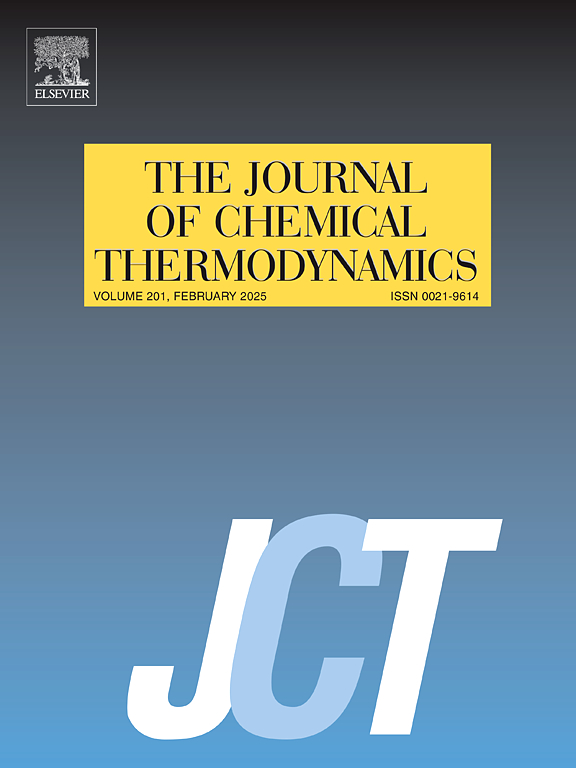MSR应用中Li, Na, K, Cs, |, F, I互反盐的热力学评价
IF 2.2
3区 工程技术
Q3 CHEMISTRY, PHYSICAL
引用次数: 0
摘要
由于熔融盐堆冷却剂和燃料溶剂的高放射毒性和挥发性,铯和碘在熔融熔盐堆冷却剂和燃料溶剂(46.5 liff -11.5 naf - 42kf mol%)中的热化学行为需要Gibbs能量模型来描述。利用有效相平衡和混合焓测量对6个组成伪二元体系LiI-CsI、LiI-KI、LiI-NaI、NaI-KI、KI-CsI和NaI-CsI进行了评价。通过对优化后的伪二元系统进行插值,得到了三元互易盐系统Li,Cs|F,I, Li,K|F,I, Li,Na|F,I, Na,K|F,I和K,Cs|F,I和K,Cs|F,I的模型,并根据观察到的行为进行了参数拟合。通过对优化后的伪二元体系进行插值,得到了可加性(共阳离子)伪三元体系的表示,并对其参数进行了必要的修改,使其最适合观测值。总的来说,所评估的系统包含了生成四阶和高阶互易盐系统描述所必需的热化学模型,其中Li,Na,Cs |f,I, Li,K,Cs |f,I和Na,K,Cs |f,I的四阶互易盐系统在很大程度上很好地再现了报道的行为。这些盐系统表示随后被纳入熔盐热性能数据库-热化学(MSTDB-TC)。本文章由计算机程序翻译,如有差异,请以英文原文为准。
Thermodynamic assessment of the Li, Na, K, Cs | F, I reciprocal salt for MSR applications
Gibbs energy models necessary to describe the thermochemical behavior of cesium and iodine in molten FLiNaK (46.5LiF-11.5NaF-42KF mol%), a proposed molten salt reactor coolant and fuel solvent, have been developed as they are of concern due to their high radiotoxicity and volatility. The six constituent pseudo-binary systems LiI-CsI, LiI-KI, LiI-NaI, NaI-KI, KI-CsI and NaI-CsI were evaluated using available phase equilibria and mixing enthalpy measurements. The models for the ternary reciprocal salt systems Li,Cs|F,I, Li,K|F,I, Li,Na|F,I, Na,K|F,I, Na,Cs|F,I and K,Cs|F,I were obtained by interpolation of the optimized pseudo-binary systems and parameters fit as necessary based on observed behavior. The additive (common cation) pseudo-ternary system representations were obtained by interpolation of the optimized pseudo-binary systems, and parameters for those as well modified as necessary to best fit observations. Together, the evaluated systems contain the necessary thermochemical models to generate quaternary and higher order reciprocal salt system descriptions, with the representations of the Li,Na,Cs|F,I, Li,K,Cs|F,I and Na,K,Cs|F,I quaternary reciprocal salt systems largely well-reproducing reported behavior. These salt system representations have subsequently been incorporated in the Molten Salt Thermal Properties Database – Thermochemical (MSTDB-TC).
求助全文
通过发布文献求助,成功后即可免费获取论文全文。
去求助
来源期刊

Journal of Chemical Thermodynamics
工程技术-热力学
CiteScore
5.60
自引率
15.40%
发文量
199
审稿时长
79 days
期刊介绍:
The Journal of Chemical Thermodynamics exists primarily for dissemination of significant new knowledge in experimental equilibrium thermodynamics and transport properties of chemical systems. The defining attributes of The Journal are the quality and relevance of the papers published.
The Journal publishes work relating to gases, liquids, solids, polymers, mixtures, solutions and interfaces. Studies on systems with variability, such as biological or bio-based materials, gas hydrates, among others, will also be considered provided these are well characterized and reproducible where possible. Experimental methods should be described in sufficient detail to allow critical assessment of the accuracy claimed.
Authors are encouraged to provide physical or chemical interpretations of the results. Articles can contain modelling sections providing representations of data or molecular insights into the properties or transformations studied. Theoretical papers on chemical thermodynamics using molecular theory or modelling are also considered.
The Journal welcomes review articles in the field of chemical thermodynamics but prospective authors should first consult one of the Editors concerning the suitability of the proposed review.
Contributions of a routine nature or reporting on uncharacterised materials are not accepted.
 求助内容:
求助内容: 应助结果提醒方式:
应助结果提醒方式:


